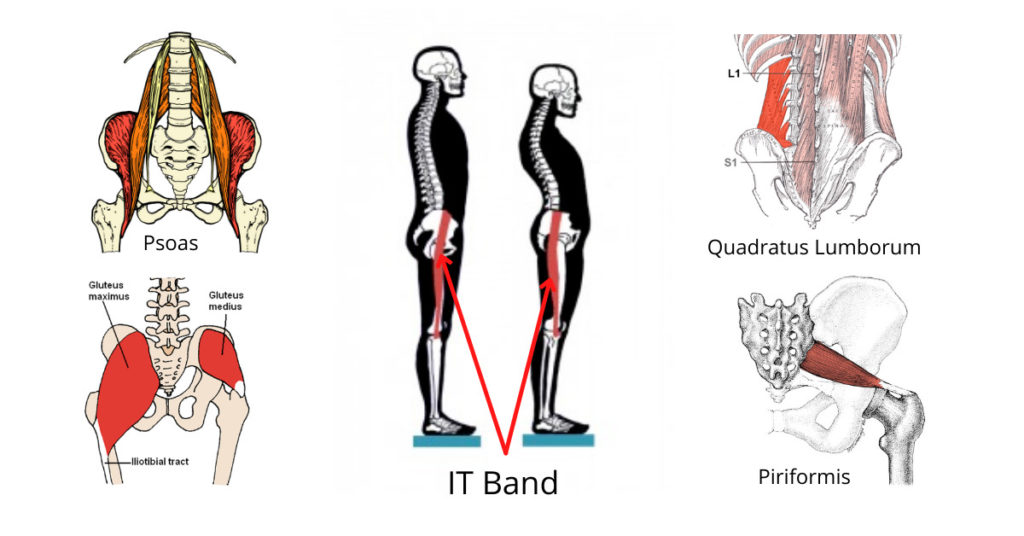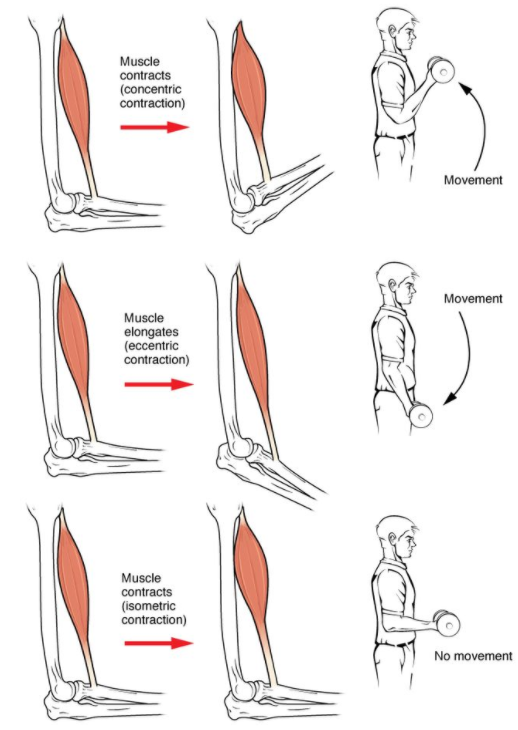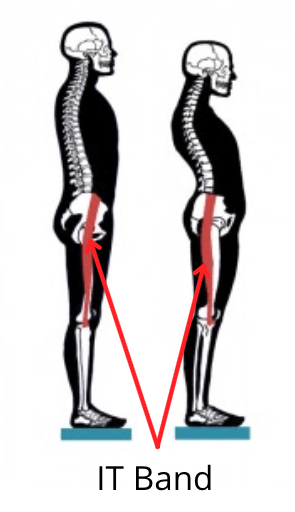“Why Does My Hip Hurt?”
I am asked this question over and over again.
Hip pain is a fairly common reason people come to see me and sign up for the CoreWalking Program.
Sadly, there are too many people who suffer mild to severe hip pain and don’t really do anything about it. The thinking goes that a hip that hurts is simply a part of their life.
“It’s not that bad, I can deal with it.”
There are many different reasons why our hips hurt and I promise you they don’t have to.
My favorite muscle the psoas is often, if not always, involved in hip pain.
The next-door neighbor of the psoas, the quadratus lumborum, usually has a role to play as well.
Let’s add gluteus maximus and piriformis to the mix and a picture begins to form.
When your hip hurts it can be any or all of these muscles.
But for today’s discussion, we’ll look at the IT band and the tensor fasciae latae as reasons why you might have outside hip pain.
But if you have a problem with one of the muscles I listed, they are probably all involved.
Because things in the body don’t work in isolation. Even though I encourage students to engage certain muscles when we exercise, that is merely an image.
Muscles work in a chain and they all work with the help of other muscles.
So when it comes to answering the question, why does my hip hurt, I start with standing posture.
Poor standing posture which also usually translates into bad walking, running, and sitting form, is a main culprit.
And it always impacts the IT Band, which means outer hip pain. Most people align the IT band incorrectly when standing.
And this misalignment carries over to all of our actions.
How Does The Body Work?
Our amazing body fascinates me to no end. Within its very specific design are some curveballs.
Things that occur in the body only once such as the hyoid– the only truly floating bone in the body. It is the only bone that doesn’t move in concert with other bones.
The IT Band is another interesting anomaly in the body. It is designed so that a muscle embedded within it, helps it to act.
Muscles move us. That’s the way the body works. Muscles contract and the bones move.
But It is important to understand that muscles can’t work effectively if they are too long and lack skeletal support.
There are a number of situations like this in the body.
When the body requires muscles that are too long to accomplish things they shouldn’t be able to, it provides assistance.
That assistance takes different forms. In the thigh muscles, we have the kneecap embedded into the quadriceps.
This bone, the patella, protects the knee joint. But it also provides essential support to the quadriceps muscle as it extends the knee.
The quadriceps is too long to do this without the help of the kneecap.
Now think about your six-pack abs. Or any six-pack if you don’t have one to show off (I don’t).
The muscle is called the rectus abdominis and it runs from the base of the ribcage to the pelvis.
In a similar way to the quadriceps, the rectus abdominis is simply too long to do its job. That job is to bring the pelvis and ribcage closer together.
In order for the rectus abdominis to do this, there are tendons inserted in between the series of muscles. So it isn’t really one long muscle.
It is a series of muscles that couldn’t accomplish their task otherwise.
What about the IT Band?
What Is An IT Band?
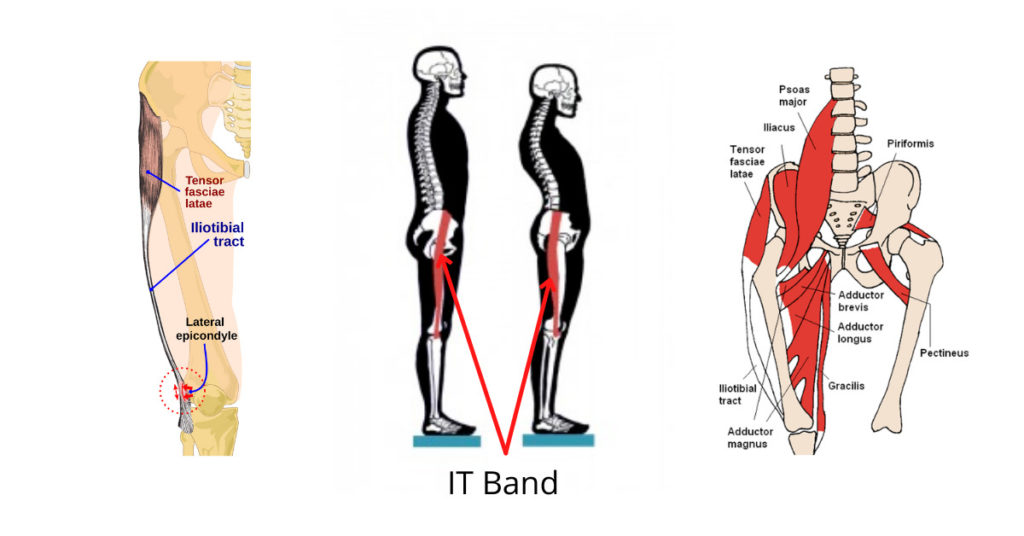 The IT band, or iliotibial band, is a long tract of connective tissue. Hip and leg pain often correspond directly to the IT Band. It runs from the ilium of the pelvis to the tibia of the shin.
The IT band, or iliotibial band, is a long tract of connective tissue. Hip and leg pain often correspond directly to the IT Band. It runs from the ilium of the pelvis to the tibia of the shin.
The body is basically made up of bones and connective tissue. Muscles, ligaments, fascia, and tendons; are all connective tissues with varying degrees of elasticity.
Fascia is a connective tissue that encases the whole body.
The fasciae latae is the deep fascia of the leg, enclosing the thigh muscles. The IT Band is fascia which is a part of the fasciae latae.
The IT Band functions to stabilize the knee when it is in extension especially for walking.
Because it is connective tissue rather than muscle, it can accomplish this action over the long distance between the pelvis and the shin.
It also works to extend and abduct the hip.
The tensor fasciae latae is a small muscle that runs through it, situated towards the outer hip.
The tensor fasciae latae does what it sounds like. Latae means broad and the tensor fasciae latae acts as a tensor of the outer fascia. The IT band is a part of the fasciae latae.
It also works with a number of the above-mentioned muscles to flex, abduct, and internally rotate the leg.
But here is the rub…
Because the IT Band is fascia, as opposed to muscle, it is much less forgiving when it comes to poor postural alignment.
Thighs that lean forward of the pelvis, a common posture problem, pull the IT band out-of-place creating the environment for the hip joint pain.
From my perspective, a majority of people lean their thighs forward of the pelvis. Just start looking around when you are with people to see if you agree.
If the thighs are forward, the IT band tends to get pulled back towards the butt.
“Why Does My Hip Hurt?”
The gluteus maximus, our big butt muscle, connects to both the back of the thigh bone and the It band.
In general, we are tight-assed people, and our tight butts will also be pulling the IT band backward.
These dual forces—thighs forward and a tight butt—put a great deal of strain on the IT band.
If it were a muscle it would simply be pulled out of alignment.
But, because it is connective tissue it has way less give. And postural misalignment affects it more than most soft tissue structures in the body.
Here is a very simple and unscientific way to feel what I am talking about.
In the picture above the IT Band in the man on the left aligns along the outer thigh as it should.
The guy on the right has thighs that lean forward which pulls the IT Band backward.
To be clear though, the IT Band doesn’t move because it is too strong and solid. So it stays where it is when your posture is bad. And this causes problems in many ways.
- Stand up and put your hands on your outer hips. Place the heel of the palm at the hip with the fingers pointing down the leg. Your hand is basically covering the IT Band.
- Lean backward and let your thighs sink forward. Feel your hands, and IT Band pull backward.
- Shift your trunk forward and take your thighs back. Now you should feel the IT Band wrap forward.
What you should feel is while the bones and the muscles will move, the taut, strong IT band will not.
The illustration above is an example of this. The IT band maintains its position as the bones shift theirs.
So today’s answer to the question, why does my hip hurt, is poor posture puts a large amount of torque on the IT band. This affects the hip and knee in equal measure.
Get your thighs back under your pelvis. If you do this there will be a lot more room for the IT band to live happily.
And there will be much less stress and pressure on the hip, leg, and knee.
Hip Pain When Walking
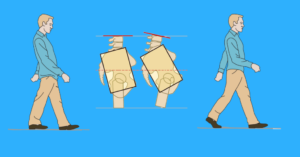 Walking is fundamental to everything we do in life.
Walking is fundamental to everything we do in life.
Even the most sedentary people are walking a few thousand steps a day.
But that doesn’t mean we are walking correctly.
And there is a correct way to walk that can help you solve all kinds of aches and pains. Including lower back, hip pain, groin pain, and more.
Hip joint pain when walking is a fairly common occurrence. It can happen for many reasons but the IT Band is almost always involved.
Consider the experiential exercise in the last section. If you felt what I suggested, what is your IT Band doing while you are standing?
Do you lean backward like the guy on the left in the picture above when you walk?
If the answer is yes, you are misaligning the IT Band with every step you take.
This leaning backward can very easily cause hip muscle pain in relation to the tensor fasciae latae.
Is the answer as simple as lean forward? Pretty much!
When you walk leaning backward you pull the IT Band and Tensor Fasciae Latae in the wrong direction.
Lean slightly forward. Let your lower body move slightly backward. Be patient and the pain in hip area is likely to diminish. Quickly.
How are you to accomplish this?
I’ll give you one simple tip. It is so basic that most people think it can’t possibly be enough.
But what do you think makes you go faster– short strides or long strides?
The most common answer is long strides but that would be wrong. Shorter steps but more of them will make you go faster.
Take shorter strides.
Shorter steps will also be a gift to your IT Band, and your hip pain when walking.
Hip Pain At Night
 “Why do my hips hurt at night”
“Why do my hips hurt at night”
Do you sleep enough?
Sleep is everything.
If you suffer from chronic pain you need sleep to heal. But, pain interrupts your sleep.
Trying to figure this out can be maddening. But strategies to get even half an hour of extra sleep a night are essential.
What position do you sleep in?
To be clear, and this can be confusing, your hip pain causes are not from sleeping. But sleeping poorly can add to your pain, or prevent healing.
The way you walk didn’t create the issues you are dealing with either.
But the way you walk can hold you back from healing.
The same goes for sleep.
There is an ideal sleep position.
It is best if we sleep on our left side with our knees slightly bent. The reason this is the best is due to cerebrospinal fluid.
Sleep helps the body regenerate daily. It does this in large part as cerebrospinal fluids wash up and down the spine.
Sleeping on the left side provides a slightly better pathway than the right side.
But what if you have left-side hip pain in life? How are you then supposed to sleep on your left side?
You aren’t, even though it is ideal. Isn’t that kind of crazy?
If you have left-side hip pain, try to sleep on your right side. If you have right-side hip pain try to sleep on your left side.
It’s kind of that simple.
You can also sleep on your back, which I have never been able to do.
If you can sleep on your side, put a thin pillow between your legs. And make sure not to hike one leg up higher than the other.
The knees have to stay together. Even if you have to tie your legs together with a bathroom sash.
The one thing you can’t do is sleep on your stomach. If you do it, stop.
How To Deal With Hip Joint Pain
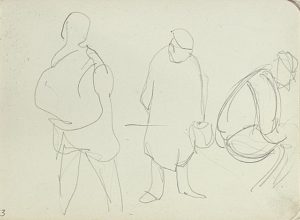 You’ve made it this far! I hope you have learned something that will help you going forward.
You’ve made it this far! I hope you have learned something that will help you going forward.
To finish, I’ll share the only tip that matters. When it comes to long-term chronic pain that shows no sign of abating only one thing counts.
One thing that can help your hip pain when sitting. It will help your hip pain when walking. And yes it will help your hip pain when sleeping.
And that one thing is… You must change.
Change the way you stand, walk, sleep, sit, breathe, exercise…
You must change.
Now the thing is– aren’t designed to embrace change. You have to overcome the resistance.
But I can tell you after years of helping people that pain is a great incentive.
In the course of this post, I have mentioned a number of things ripe for change.
For standing, take your trunk slightly forward and your legs back.
For walking, take shorter steps and feel good things happen.
For sleeping, tie your knees together and try to sleep on your side.
Pick one of these tips and give it a shot.
And what have you got to lose? If nothing else has helped, maybe it is time for some radical changes to how you use your body.

